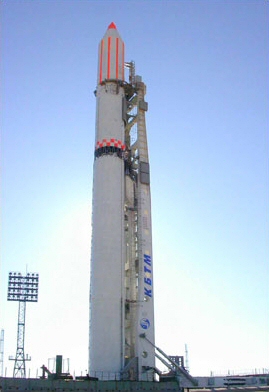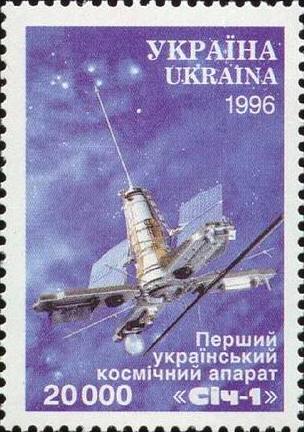
Plesetsk Cosmodrome is a Russian spaceport located in Mirny, Arkhangelsk Oblast, about 800 km north of Moscow and approximately 200 km south of Arkhangelsk. As of 2024, it is Europe's only operational orbital spaceport and the northernmost spaceport in the world. Originally developed as an ICBM site for the R-7 missile, it also served for numerous satellite launches using the R-7 and other rockets. Its high latitude makes it useful only for certain types of launches, especially the Molniya orbits, so for much of the site's history it functioned as a secondary location, with most orbital launches taking place from Baikonur, in the Kazakh SSR. With the end of the Soviet Union, Baikonur became a foreign territory, and Kazakhstan charged $115 million usage fees annually. Consequently, Plesetsk has seen considerably more activity since the 2000s.

Zenit was a family of space launch vehicles designed by the Yuzhnoye Design Bureau in Dnipro, Ukraine, which was then part of the Soviet Union. Zenit was originally built in the 1980s for two purposes: as a liquid rocket booster for the Energia rocket and, equipped with a second stage, as a stand-alone middle-weight launcher with a payload greater than the 7 tonnes of the Soyuz but smaller than the 20 tonnes payload of the Proton. The last rocket family developed in the USSR, the Zenit was intended as an eventual replacement for the dated Soyuz and Proton families, and it would employ propellants which were safer and less toxic than the Proton's nitrogen tetroxide/UDMH mix. Zenit was planned to take over crewed spaceship launches from Soyuz, but these plans were abandoned after the dissolution of the Soviet Union in 1991.
The Tsyklon, GRAU index 11K67, was a Soviet-designed expendable launch system, primarily used to put Cosmos satellites into low Earth orbit in the late-1960s. It is based on the R-36 intercontinental ballistic missile designed by Mikhail Yangel and made eight launches, with seven successes and one failure. All of its launches were conducted from LC-90 at the Baikonur Cosmodrome. It is sometimes designated Tsyklon-2A, not to be confused with the later Tsyklon-2 rocket. It was introduced in 1967 and was derived from the R-36 ICBM. It was retired in 1969.

The Angara rocket family is a family of launch vehicles being developed by the Moscow-based Khrunichev State Research and Production Space Center. The launch vehicles are to put between 3,800 kg (8,400 lb) and 24,500 kg (54,000 lb) into low Earth orbit and are intended, along with Soyuz-2 variants, to replace several existing launch vehicles.

The State Space Agency of Ukraine is the Ukrainian government agency responsible for space policy and programs. It was formed on 29 February 1992, and was based on the Soviet space program infrastructure that remained in Ukraine following the dissolution of the Soviet Union. It was called the National Space Agency of Ukraine until 9 December 2010.

The Meteor spacecraft are weather observation satellites launched by the Soviet Union and Russia since the Cold War. The Meteor satellite series was initially developed during the 1960s. The Meteor satellites were designed to monitor atmospheric and sea-surface temperatures, humidity, radiation, sea ice conditions, snow-cover, and clouds. Between 1964 and 1969, a total of eleven Soviet Union Meteor satellites were launched.

Soyuz 2 is a modernized expendable medium-lift launch vehicle and the seventh major version of the Soyuz rocket family. It includes key enhancements over its predecessors including improved engines along with digital flight control and telemetry systems, enabling launches from fixed platforms and the use of large payload fairings.

The Zenit-2 was a Ukrainian, previously Soviet, expendable carrier rocket. First flown in 1985, it has been launched 37 times, with 6 failures. It is a member of the Zenit family of rockets and was designed by the Yuzhmash.

The Tsyklon-4, also known as Tsiklon-4 and Cyclone-4, was a Ukrainian carrier rocket which was being developed for commercial satellite launches. Derived from the Tsyklon-3, it had a new third stage, a larger payload fairing, and a modernised flight control system compared to its predecessor. The control system had been developed by JSC Khartron.

Sich-1 was the first Ukrainian Earth observation satellite and was launched on 31 August 1995 at 06:49:59 UTC by Ukrainian Tsyklon-3 rocket from Plesetsk Cosmodrome in Russia. It operated until 2001.
Kosmos 176, also known as DS-P1-Yu No.10 was a Soviet satellite which was used as a radar calibration target for tests of anti-ballistic missiles. It was a 400 kilograms (880 lb) spacecraft, was built by the Yuzhnoye Design Office, and launched in 1967 as part of the Dnepropetrovsk Sputnik programme.
Kosmos 191, also known as DS-P1-Yu No.9 was a Soviet satellite which was used as a radar calibration target for tests of anti-ballistic missiles. It was built by the Yuzhnoye Design Office, and launched in 1967 as part of the Dnepropetrovsk Sputnik programme.
Kosmos 319, known before launch as DS-P1-Yu No.25, was a Soviet satellite which was launched in 1970 as part of the Dnepropetrovsk Sputnik programme. It was a 250-kilogram (550 lb) spacecraft, which was built by the Yuzhnoye Design Bureau, and was used as a radar calibration target for anti-ballistic missile tests.
Kosmos 380, known before launch as DS-P1-Yu No.26, was a Soviet satellite which was launched in 1970 as part of the Dnepropetrovsk Sputnik programme. It was a 250-kilogram (550 lb) spacecraft, which was built by the Yuzhnoye Design Bureau, and was used as a radar calibration target for anti-ballistic missile tests.
Kosmos 668, also known as DS-P1-Yu No.74, was a Soviet satellite which was launched in 1974 as part of the Dnepropetrovsk Sputnik programme. It was a 400-kilogram (880 lb) spacecraft, which was built by the Yuzhnoye Design Bureau, and was used as a radar calibration target for anti-ballistic missile tests.
Kosmos 321, also known as DS-U2-MG No.1, was a Soviet satellite which was launched in 1970 as part of the Dnepropetrovsk Sputnik programme. It was a 365-kilogram (805 lb) spacecraft, which was built by the Yuzhnoye Design Bureau, and was used to investigate the magnetic poles of the Earth.
Kosmos 378, also known as DS-U2-IP No.1, was a Soviet satellite which was launched in 1970 as part of the Dnepropetrovsk Sputnik programme. It was a 710-kilogram (1,570 lb) spacecraft, which was built by the Yuzhnoye Design Bureau, and was used to study the ionosphere.
Kosmos 1805 was a Soviet electronic intelligence satellite which was launched in 1986. The first of four Tselina-R satellites to fly, it was constructed by Yuzhnoye with its ELINT payload manufactured by TsNII-108 GKRE. Since it ceased operations it has remained in orbit as space junk, and in April 2012 NASA's Fermi Gamma-ray Space Telescope was forced to maneuver to avoid a collision with the derelict satellite.
The RD-861 is a Soviet liquid propellant rocket engine burning UDMH and nitrogen tetroxide in a gas generator combustion cycle. It has a main combustion chamber, with four vernier nozzles fed by the gas generator output. It can be reignited a single time.
Kosmos 2126, also known as Cosmos 2126, was a Russian Satellite that was part of the Strela-1M generation of communications satellites that operated in low Earth orbit to collect (store) information then forward (dump) it to a ground station when overhead of its ground station. Kosmos-2126 was launched in 1991 from the Plesetsk Cosmodrome.








